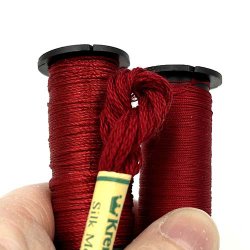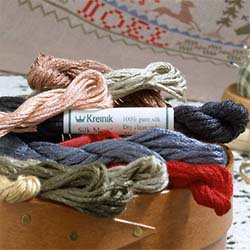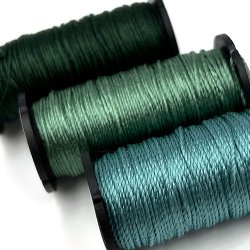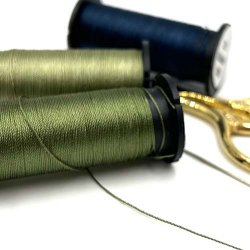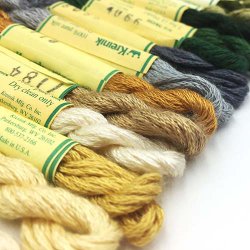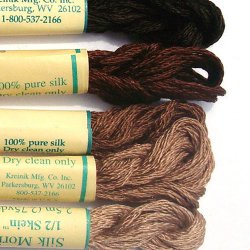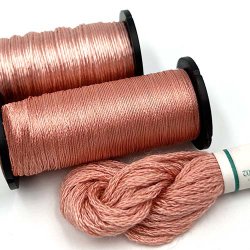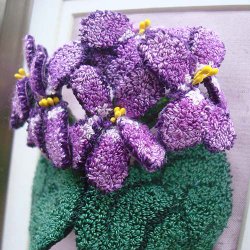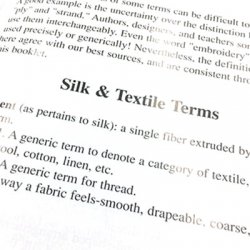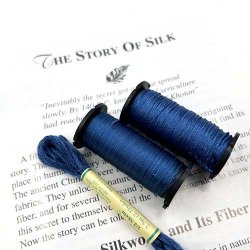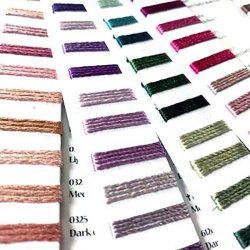How to use silk threads
It's always a good idea to educate yourself on different fibers and creative materials. To learn about silk and the many ways you can use it, start here.
-
Kreinik Silk Thread Widths
Jewelry makers and other fiber artists often choose thread by their width. Whether you’re working with wire, beads, needles, or general crafts, now you can choose the right Kreinik thread width for your project.
mm means millimeter
KREINIK THREAD NAME + WIDTH
Silk Mori, one strand 0.4mm
Silk Mori Milkpaint, one strand 0.4mm
Silk Mori is a floss, comparable to DMC or Anchor Embroidery floss in size
Silk Serica .34mm
Silk Serica is a twisted silk, comparable to a DMC #3 or #5 Pearl Cotton in size
Silk Bella .21mm
Silk Bella is a thin twisted silk, comparable to a DMC #12 Pearl Cotton in size
-
Silk Thread History
Since it was first processed in China, silk thread has been used in embroidery for more than 5,000 years. Silk is an animal fiber made from the viscous fluid of the silkworm. Originally, silkworm cocoons were collected from trees. In 2640 B.C., a Chinese Empress discovered that if a silk cocoon was placed in hot water to soften the natural glue or sericin (holds the cocoon together), then a silk cocoon could be unwound and stretched into a long filament. Fo Xi, China's first Emperor, taught the Chinese people to cultivate mulberry trees and raise silkworms.
The first variety of silkworm to be domesticated was the Bombyx Mori. Over the centuries, at least thirteen other species have been cultivated. In addition, there are more than 80 varieties of wild silkworms. In the history of needlework, silk was a primary thread for embroidery, used in tapestries and garments, blackwork, and samplers. When the world was at war in the beginning of the 1940's, however, the silk supply literally dried up overnight. Chemical companies developed synthetic fibers commercially, and these fibers replaced silk almost instantly. As a result, for more than fifty years, people have looked upon silk as rare, expensive and delicate.
Today, embroiderers acknowledge silk for its practical and lustrous qualities. The translucent cellular structure of silk allows it to absorb dyes and to reflect light to a high degree, giving the finished product a pure color and a beautiful luster. When worked in specialty stitches and laid properly, silk has a bright sheen unrivaled by other threads. Due to the different cellular structures of silk and cotton, for example, silk is very smooth while cotton is fuzzy.
Silk also remains lustrous and strong over time, while cotton loses its luster and strength. Archaeologists found that silk in China, buried in tombs for 3,000 years, was the only fiber that remained intact and recognizable. Also, in Sweden, while dredging a channel in the harbor where an old warehouse had burned, black silk skeins buried under mud for 27 years were discovered. After cleaning, they found that the color, strength, and lustre still remained.
Choose silk thread for its unparalleled lustre, texture, and elegance. It adds a richness that raises your needlework to a higher level. Whether used in sampler work, needlepoint, or other techniques, silk threads enable needleworkers to play with light and with textures in their stitchery. It is an affordable thread that is perfect for treasured, keepsake needlework. Its softness, too, makes silk the ultimate in luxurious stitching enjoyment.
-
How to use Kreinik Silk Serica®
Silk Serica® can be used as is, straight from the reel, as a 3-ply twisted filament silk. It can also be separated and used as a flat silk. Made of 100% pure filament silk, the sheen is so rich and bright, it instantly turns any design into a work of art. Perfect in heirloom projects and designs focusing on different textures.
The most important tip to remember when working with Silk Serica: moisturize your hands with a non-greasy hand cream. This will keep the filament silk from snagging on rough spots.
See Description below for more tips and usage ideas.
-
How to use Kreinik Silk Bella™
Silk Bella™ is the thinnest of the Kreinik silk threads. It is a filament silk with a bright sheen, visible in designs even with it's small weight. It is a beautiful thread when used in any stitch, in any technique. Silk Bella is dyed in colors to match Silk Mori® and Silk Serica®.
Content: 100% pure filament silk
Care
Silk Bella should only be dry cleaned. Do not wash or wet block silk work. Do not use an embroidery hoop with silk thread in hand stitchery, as the rings, markings or folds left in the fabric cannot be removed by washing the piece. Instead, use stretcher bars, Q-snaps, or scroll frames.
Applications
Appliqué (hand and machine), blackwork, costume making, crazy quilting (hand and machine), crewel, crochet, cross stitch/counted thread, couching, doll making (hand or machine), hardanger, Japanese embroidery, knitting, lace making, machine embroidery/bobbin work, machine embroidery/couching, miniatures, needlepoint/canvas work, punch embroidery, ribbon embroidery (hand and machine), smocking, stumpwork, weaving.
Hand Embroidery, Cross Stitch, Samplers, Needlepoint
Silk Bella is ideal for a variety of stitches in samplers, hardanger, crewel, stumpwork, pulled work, crazy quilting, petit point, and needlepoint or canvas work. Use it straight from the reel as a 3-ply twisted thread for tent stitch, satin stitch, kloster blocks and other stitches that showcase its texture. It is similar in weight to a #12 Pearl Cotton. Do not separate strands; use as is, straight off the reel.
Tips on using Silk Bella
- To keep your stitching looking its best, take time to wash your hands before stitching. Use a non-greasy hand cream to moisturize hands and prevent the silk from snagging on dry skin or cuticles.
- Prepare your ground material (fabric or canvas) prior to stitching to prevent the silk from snagging on rough edges. Turn the edges under with a running stitch, or cover the edges with tape.
- Silk Bella® comes on a snap-spool mechanism. Both sides of the spool open; look for the side where the thread end is located. Insert your thumbnail under the cap, and rotate the spool while gently lifting the cap to release the thread (the cap should not pop off). Snap the lid shut to secure the unused portion.
- Use lengths of silk no longer than 45cm (18 inches) for better thread control and reduced thread abrasion from repeated passes through the ground material. Use a needle large enough to 'open' the hole in the fabric to allow the silk thread to go through easily.
- It is important to maintain Silk Bella's twist as it comes from the spool to ensure uniform stitches from beginning to end. Since all of us as stitchers twist our needles a little bit while stitching, apply a slight reverse twist to your needle, or allow your needle to dangle every one or two stitches. This will prevent the softly twisted silk from untwisting or becoming too tightly twisted.
-
How to use Kreinik Silk Mori®
Kreinik Silk Mori® is a 6-strand spun silk. That means:
- as a spun silk, it has a creamy natural luster (as opposed to a filament silk, which has a bright sheen)
- you can separate the strands and recombine to suit whatever your stitch is on whatever fabric or canvas you're using—two strands of Silk Mori is ideal for cross stitch on 14-count Aida, for instance.
- you can use it in place of cotton embroidery floss, when you want to elevate a design (creating an heirloom), when you want to show off the beautiful natural sheen of silk (like in samplers), or simply when you want to spoil your eyes and your fingers (it's so soft!)
Read the Description below for stitching tips and usage ideas for Kreinik Silk Mori.
-
Alternate skin color choices
Personalize a design by stitching faces and bodies in particular skin tones. The following are suggestions for popular "flesh" color choices and hair color choices of Kreinik Silk Mori®. Explore the whole palette of Mori colors for more variations in skin tones.
African-American:- palest shade - 7133 Light Bark
- light shade - 7134 Medium Bark
- medium shade - 7135 Medium Dark Mocha
- lightest hair shade - 7136 Dark Mocha
- medium hair shade - 7166 Dark Brown Black
- dark hair shade - 8050 Black
Asian:
- palest shade - 0903 Light Cinnamon
- light shade - 0743 Light Oystershell
- medium shade - 0724 Medium Wheat
- lightest hair shade - 7136 Dark Mocha
- medium hair shade - 7166 Dark Brown Black
- dark hair shade - 8050 Black
Hispanic:
- palest shade - 0704 Medium Buttermilk
- light shade - 0903 Light Cinnamon
- medium shade - 7024 Antique Parchment
- lightest hair shade - 7136 Dark Mocha
- medium hair shade - 7166 Dark Brown Black
- dark hair shade - 8050 Black
Caucasian:
- palest shade - 3021 Sherbet
- light shade - 9032 Lightest Neutral Flesh
- medium shade - 9034 Medium Neutral Flesh
-
Silk Thread Conversion Charts
Convert designs from cotton floss or other threads to Kreinik silk threads. Click on one of the links below to view and print our silk thread conversion charts.
Find the closest match for DMC to Kreinik Silk Mori®
DMC Cotton Floss to Kreinik Silk Mori® Conversion ChartFind the closest match for Anchor to Kreinik Silk Mori®
Anchor Cotton Floss to Kreinik Silk Mori® Conversion ChartFind the closest match for Pearsalls Silk to Kreinik Silk Mori®
Pearsalls Silk to Kreinik Silk Mori Conversion ChartFind the closest match for Soie d'Alger to Kreinik Silk Mori®
Soie d' Alger Floss to Kreinik Silk Mori® Conversion ChartFind the closest match for Pearl Cotton to Kreinik Silk Serica®
Pearl Cotton to Kreinik Silk Serica® Conversion ChartFind the closest match for Pearl Cotton to Kreinik Silk Bella™
Pearl Cotton to Kreinik Silk Bella™ Conversion Chart -
Punchneedle Selection Chart
There are three basic needles used for the punchneedle embroidery technique: 1-strand, 3-strand, and 6-strand needles. This chart matches Kreinik threads for punchneedle with the proper punchneedle size:

-
Stitcher's Guide To Silk Threads booklet
Learn about Kreinik's three silk threads. Includes the history of silk, tips on stitching with silk, and a free counted thread chart by Betsy Foster. Quick, useful resource. Paperback.
-
Stitcher's Guide to Silk Thread booklet PLUS THREADS
Includes one of each Kreinik silk—Silk Mori, Silk Serica, and Silk Bella—plus the "A Stitcher's Guide to Silk Threads" booklet (softcover, includes history and stitching tips). Colors may vary from what is shown.
-
Kreinik Silk Thread Color Card
See 150+ beautiful silk colors of Mori, Serica, and Bella for your next project (actual thread swatches, not photos). Includes the popular Milkpaint colors.



